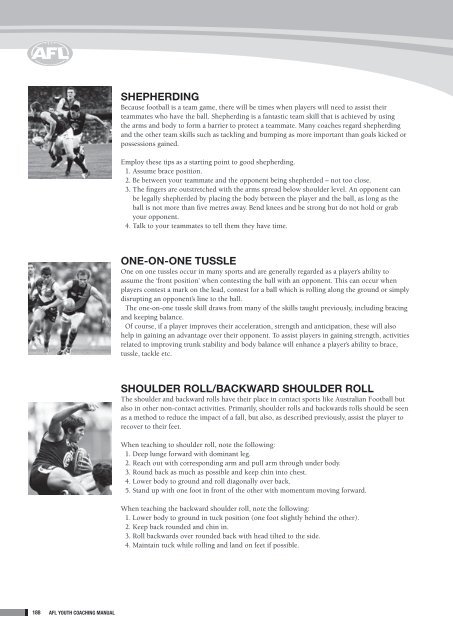2012 Youth Coaching Manual - AFL Community
2012 Youth Coaching Manual - AFL Community
2012 Youth Coaching Manual - AFL Community
Create successful ePaper yourself
Turn your PDF publications into a flip-book with our unique Google optimized e-Paper software.
Shepherding<br />
Because football is a team game, there will be times when players will need to assist their<br />
teammates who have the ball. Shepherding is a fantastic team skill that is achieved by using<br />
the arms and body to form a barrier to protect a teammate. Many coaches regard shepherding<br />
and the other team skills such as tackling and bumping as more important than goals kicked or<br />
possessions gained.<br />
Employ these tips as a starting point to good shepherding.<br />
1. Assume brace position.<br />
2. Be between your teammate and the opponent being shepherded – not too close.<br />
3. The fingers are outstretched with the arms spread below shoulder level. An opponent can<br />
be legally shepherded by placing the body between the player and the ball, as long as the<br />
ball is not more than five metres away. Bend knees and be strong but do not hold or grab<br />
your opponent.<br />
4. Talk to your teammates to tell them they have time.<br />
One-on-one tussle<br />
One on one tussles occur in many sports and are generally regarded as a player’s ability to<br />
assume the ‘front position’ when contesting the ball with an opponent. This can occur when<br />
players contest a mark on the lead, contest for a ball which is rolling along the ground or simply<br />
disrupting an opponent’s line to the ball.<br />
The one-on-one tussle skill draws from many of the skills taught previously, including bracing<br />
and keeping balance.<br />
Of course, if a player improves their acceleration, strength and anticipation, these will also<br />
help in gaining an advantage over their opponent. To assist players in gaining strength, activities<br />
related to improving trunk stability and body balance will enhance a player’s ability to brace,<br />
tussle, tackle etc.<br />
Shoulder roll/backward shoulder roll<br />
The shoulder and backward rolls have their place in contact sports like Australian Football but<br />
also in other non-contact activities. Primarily, shoulder rolls and backwards rolls should be seen<br />
as a method to reduce the impact of a fall, but also, as described previously, assist the player to<br />
recover to their feet.<br />
When teaching to shoulder roll, note the following:<br />
1. Deep lunge forward with dominant leg.<br />
2. Reach out with corresponding arm and pull arm through under body.<br />
3. Round back as much as possible and keep chin into chest.<br />
4. Lower body to ground and roll diagonally over back.<br />
5. Stand up with one foot in front of the other with momentum moving forward.<br />
When teaching the backward shoulder roll, note the following:<br />
1. Lower body to ground in tuck position (one foot slightly behind the other).<br />
2. Keep back rounded and chin in.<br />
3. Roll backwards over rounded back with head tilted to the side.<br />
4. Maintain tuck while rolling and land on feet if possible.<br />
188 <strong>AFL</strong> <strong>Youth</strong> <strong>Coaching</strong> <strong>Manual</strong>

















